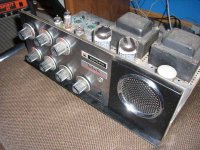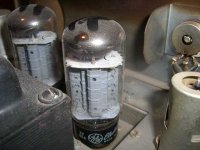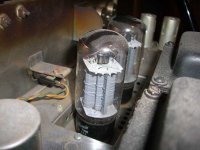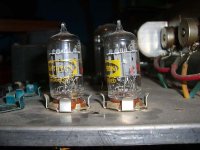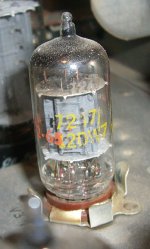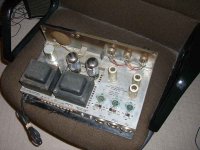The 6550 needs more drive - it will work, but may not produce full output without distortion (from the driver). Grid resistors should be lowered to 100K or less, and bais supply may not have enough range to bias them correctly. Other than that, it's a drop-in.
8417s will COST you though... The Sylvania (Philips) ones are supposed to be best... lower the grid resistors to 100K if you have GEs.
There's no Sams folder for CHB-50. The schematic you have should be close for the front end. Power amp section is simple enough.
8417s will COST you though... The Sylvania (Philips) ones are supposed to be best... lower the grid resistors to 100K if you have GEs.
There's no Sams folder for CHB-50. The schematic you have should be close for the front end. Power amp section is simple enough.
I once had a MO-100A (quad 8417) on the bench. For giggles I measured the primary impedance of the output transformer and found it to be about 4.5k.
It looks like the M120 used a quad of 8417's also.
Pics of the GE 8417s. They look to be in good physical shape, haven't tested them yet though.
What's the best way to test the amp? Should I put it somewhere where it won't harm anything, plug it in (non-polarized two-prong plug by the way), switch it on, and see if the tubes light up? Do I have to have a load on the output terminals if I don't put any input signal through it?
What's the best way to test the amp? Should I put it somewhere where it won't harm anything, plug it in (non-polarized two-prong plug by the way), switch it on, and see if the tubes light up? Do I have to have a load on the output terminals if I don't put any input signal through it?
Attachments
Turbo7MN said:What's the best way to test the amp? Should I put it somewhere where it won't harm anything, plug it in (non-polarized two-prong plug by the way), switch it on, and see if the tubes light up? Do I have to have a load on the output terminals if I don't put any input signal through it?
What I've done to bring up old, unknown amps is to:
search for schematic, if not found, trace out and write it down
put an old car speaker on the outputs
pop the lid and connect a dvm to B+
short input
bring up *slowly* on a varaic (say 1-2 hours to get to 115vac)
measure voltages at *all pins*.
make sure input (grids) are at 0vdc, cathodes are biased correctly, power on tubes (plate to cathode) isn't too far out of spec.
Once I feel good about these, plug in a "disposable" mp3 player and see how it sounds.
rick
Wow, haven't updated this in a while. It did fire up nicely, I did have a problem to begin with that turned out to be a bad speaker wire (yeah, ran it with no load and it's still fine  ) but I've been playing through it for most of the week with the insides still original for now. I ghetto-rigged some conectors to plug in the guitar and speaker cab.
) but I've been playing through it for most of the week with the insides still original for now. I ghetto-rigged some conectors to plug in the guitar and speaker cab.
I'm not sure I even want to mod it. I was expecting something that would be pretty clean until I modded it, but the disortion this thing is capable of is insane. I can't really get a clean tone out of it, but I can get pretty nice heavy metal tones without any sort of pedal.
The thing that concerns me is that it seems unnaturally quiet. I'm playing it through a Peavey cab with a 12" and 10", and it's about loud enough for a practice amp in my room, but if I were to take it on stage I would almost certainly have to mic it. I know it can't possibly be putting out the full 60W. Anyone have any ideas?
-Darren
 ) but I've been playing through it for most of the week with the insides still original for now. I ghetto-rigged some conectors to plug in the guitar and speaker cab.
) but I've been playing through it for most of the week with the insides still original for now. I ghetto-rigged some conectors to plug in the guitar and speaker cab.I'm not sure I even want to mod it. I was expecting something that would be pretty clean until I modded it, but the disortion this thing is capable of is insane. I can't really get a clean tone out of it, but I can get pretty nice heavy metal tones without any sort of pedal.
The thing that concerns me is that it seems unnaturally quiet. I'm playing it through a Peavey cab with a 12" and 10", and it's about loud enough for a practice amp in my room, but if I were to take it on stage I would almost certainly have to mic it. I know it can't possibly be putting out the full 60W. Anyone have any ideas?
-Darren
Hi Darren,
Distortion is one clue, lack of power is the other. Bogen's 60 watts are "real watts". Replace all the coupling caps to start with. You may have an open or high value cathode resistor. Plate resistors around 220K seem to drift the most - up. I can see many areas that could cause your troubles.
Did you test the output tubes?
-Chris
Distortion is one clue, lack of power is the other. Bogen's 60 watts are "real watts". Replace all the coupling caps to start with. You may have an open or high value cathode resistor. Plate resistors around 220K seem to drift the most - up. I can see many areas that could cause your troubles.
Did you test the output tubes?
-Chris
Hmm, no I didn't test the output tubes. This thing uses a pair of 8417s that are incredibly rare and expensive, I plan on using this pair until they die altogether. The only thing I really tested before I plugged it in was to make sure there was -17 volts on pin 5. I don't even know where I can get the tubes tested.
Unfortunately I can't find a schematic for this model, so I'm not entirely sure how everything is laid out. I did take the bottom off just to check for any obvious damage or anything that could cause problems, and it all looked good. I've never worked with any amplifier circuits before and I'm not sure which ones would be the coupling caps. If I posted a couple pics of the internal wiring, could you point out what I should replace and/or check?
In the meantime, is it still safe to play through?
-Darren
Unfortunately I can't find a schematic for this model, so I'm not entirely sure how everything is laid out. I did take the bottom off just to check for any obvious damage or anything that could cause problems, and it all looked good. I've never worked with any amplifier circuits before and I'm not sure which ones would be the coupling caps. If I posted a couple pics of the internal wiring, could you point out what I should replace and/or check?
In the meantime, is it still safe to play through?
-Darren
I've come across those symptoms before - sweet creamy distortion without much volume. A lot of times it turns out that one of the output tubes is shot. The result is that there's a lot of imbalance current through the transformer; it's saturated even at idle, or it takes very little signal to saturate.
Is there an easy way to measure the cathode current of each tube? There may be a small resistor on each cathode just for that purpose. There might even be a pot that's been turned all the way to one side by some monkey.
-- Dave
Is there an easy way to measure the cathode current of each tube? There may be a small resistor on each cathode just for that purpose. There might even be a pot that's been turned all the way to one side by some monkey.
-- Dave
I'll check it out. Which pins would it be off of? (here's a pinout)
http://tdsl.duncanamps.com/dcigna/tubes/sheets/sylvania/syl-465h.gif
I was hoping to avoid actually prodding around in there with it powered up for as long as possible. I guess all I know about the output tubes it that they look exactly the same in every way I can tell, even when they are powered up (glow the same brightness, etc.). Apparently this doesn't mean anything though.
What exactly should I be looking for as far as measurements? Can this be checked without the tubes in there?
I'm sorry, I thought I understood how most of this works but I'm unfamiliar with the terminology.
http://tdsl.duncanamps.com/dcigna/tubes/sheets/sylvania/syl-465h.gif
I was hoping to avoid actually prodding around in there with it powered up for as long as possible. I guess all I know about the output tubes it that they look exactly the same in every way I can tell, even when they are powered up (glow the same brightness, etc.). Apparently this doesn't mean anything though.
What exactly should I be looking for as far as measurements? Can this be checked without the tubes in there?
I'm sorry, I thought I understood how most of this works but I'm unfamiliar with the terminology.
Okay, I looked and couldn't seem to find what you are talking about. I'm going to try emailing Bogen to see if I can get a schematic for this thing, I have no idea what I'm doing right now.
Anyway, here's a shot of the inside.
http://www.teamfc3s.org/forum/attachment.php?s=&postid=514341
Closeup of the output tube sockets, but a little out of focus.
http://www.teamfc3s.org/forum/attachment.php?s=&postid=514342
I can get pictures of anything else. I'm not one to randomly start prodding into high voltage stuff without knowing exactly what I'm looking for, so I'm going to hold off doing anything with it until I get a sense of what to test.
If in fact one of the tubes is bad, will it hurt the amp any to keep playing through it?
-Darren
Anyway, here's a shot of the inside.
http://www.teamfc3s.org/forum/attachment.php?s=&postid=514341
Closeup of the output tube sockets, but a little out of focus.
http://www.teamfc3s.org/forum/attachment.php?s=&postid=514342
I can get pictures of anything else. I'm not one to randomly start prodding into high voltage stuff without knowing exactly what I'm looking for, so I'm going to hold off doing anything with it until I get a sense of what to test.
If in fact one of the tubes is bad, will it hurt the amp any to keep playing through it?
-Darren
Hi Darren,
A general rule of thumb is: "if it ain't workin' right, don't use it".
Have you read the safety thread near the top of this forum? If not, DO IT!
There are two ways to test these tubes. Replacement (and adjust per the manual) or take the tubes in for testing. There must be a DIY member or good service shop near you.
-Chris
A general rule of thumb is: "if it ain't workin' right, don't use it".
Have you read the safety thread near the top of this forum? If not, DO IT!
There are two ways to test these tubes. Replacement (and adjust per the manual) or take the tubes in for testing. There must be a DIY member or good service shop near you.
-Chris
Nope, I checked with the only music shop around here and they don't test tubes, I can't think of any other places that possibly would.
I have read the safety warnings, I just love the sound of this thing. If I'm gonna have to replace the tubes anyway, I'd like to enjoy the awesome sound while I can.
I don't have the manual for the amp. In my case, tube replacement would probably consist of converting it to KT88s. From what I've gathered, the 8417 is a great sounding tube, but rather unstable.
I have read the safety warnings, I just love the sound of this thing. If I'm gonna have to replace the tubes anyway, I'd like to enjoy the awesome sound while I can.
I don't have the manual for the amp. In my case, tube replacement would probably consist of converting it to KT88s. From what I've gathered, the 8417 is a great sounding tube, but rather unstable.
From what I've gathered, the 8417 is a great sounding tube, but rather unstable.
Burnedfingers has a thread on a conversion similar to yours here
Have a read. I think it might be a valid idea.
-Chris
Thanks for the link. I remember seeing it when I was first doing research on the 8417 but I didn't read too far into it then.
So it looks like for now, this weekend's project is going to be testing resistors. Is there any good way to test for a bad cap? I plan on replacing them anyway, but I would like to know the condition of the current ones.
So it looks like for now, this weekend's project is going to be testing resistors. Is there any good way to test for a bad cap? I plan on replacing them anyway, but I would like to know the condition of the current ones.
Those thick black wires are connected to the cathodes. From the picture it looks like they lead to the pot in between the tubes. It appears to be a bias pot of some kind. It's hard to tell from the picture what the pot does exactly. If the amp were on the bench in front of me there are a lot of things I would look at, but if you don't feel comfortable probing around in there, then I don't feel comfortable giving you suggestions here.
I think you need to get a schematic. As daunting as it might seem, there's no better way to get to know what you've got than to trace out a schematic yourself. You would start with a spaghetti mess that will take a few iterations of redrawing to get it to look like a 'normal' schematic. It can be a big job, especially with a complex amp. But you'd learn a tremendous amount in the process. If learning is your goal then you might give it a try.
-- Dave
I think you need to get a schematic. As daunting as it might seem, there's no better way to get to know what you've got than to trace out a schematic yourself. You would start with a spaghetti mess that will take a few iterations of redrawing to get it to look like a 'normal' schematic. It can be a big job, especially with a complex amp. But you'd learn a tremendous amount in the process. If learning is your goal then you might give it a try.
-- Dave
- Status
- Not open for further replies.
- Home
- Live Sound
- Instruments and Amps
- Bogen PA to Guitar Amp, few questions
